If you’re looking for a short thru hike in the mountains, the John Muir Trail and Colorado Trail should both be on your list. Between July and September these trails come alive with colorful wildflowers, gorgeous vistas, and lots of starry-eyed thru hikers on grand adventures. (Also mosquitos, but let’s focus on the positive.)
I’ve thru hiked both, and they do have a lot in common: high mountain scenery, challenging elevation profiles, and nearly constant wild camping opportunities, to name just a few. If you’re debating between the JMT and the CT for your next thru hike, you truly can’t go wrong with either.
But for all they have in common, each has its own distinct flavor. The Colorado Trail is longer, simpler to plan, and has more of a typical thru hike vibe. The John Muir Trail is a bit burlier per mile, requires more detailed planning, and (to me) feels more like an extended backpacking trip than a traditional thru hike.
This post shares my take on how these two incredible trails compare, and I hope it helps you choose which one to tackle next. Don’t worry, you can — and definitely should — hike them both eventually!
Time Needed
The JMT is much shorter and takes less time to hike. If you can only spare 2-3 weeks and are set on an end-to-end thru hike, go for the JMT. If you want a longer project that feels a bit more committing, tackle the CT.
The complete John Muir Trail is 211 miles long and is said to take 3-4 weeks on average. That’s an average of about 9 miles per day.
The longer Colorado Trail is about 480 miles, or 2.3 times as long as the JMT, and is said to take most hikers 4-6 weeks. That works out to an average of 14 miles per day.
Why is the average daily mileage on the CT higher than the JMT? Several reasons:
Trail legs: by the time you work up to longer days on the JMT, you’re finished. On the CT you still have a couple hundred miles to go after building up your hiking fitness, allowing you to hike longer average days overall.

The Colorado Trail takes most people 4-6 weeks to complete, so you’ll have plenty of time to enjoy your “trail legs” after you get in shape.
Experience: As a generalization, the JMT is more popular as a first thru hike. The Colorado Trail, being longer and less famous, seems to be more popular with experienced long-distance trail veterans (PCT, AT, CDT) who tend to put down longer days.
Scenery and remoteness: Both these trails are incredibly scenic, but the JMT has the highest concentration of stunning scenery per mile and more remote terrain that can’t be reached by day hiking. On the most remote and scenic sections it’s common for JMT hikers to linger and take a side trip or two, lowering their average daily forward mileage. Of course, CT hikers often take side trips to summit 14ers along the way, so this may be a wash.
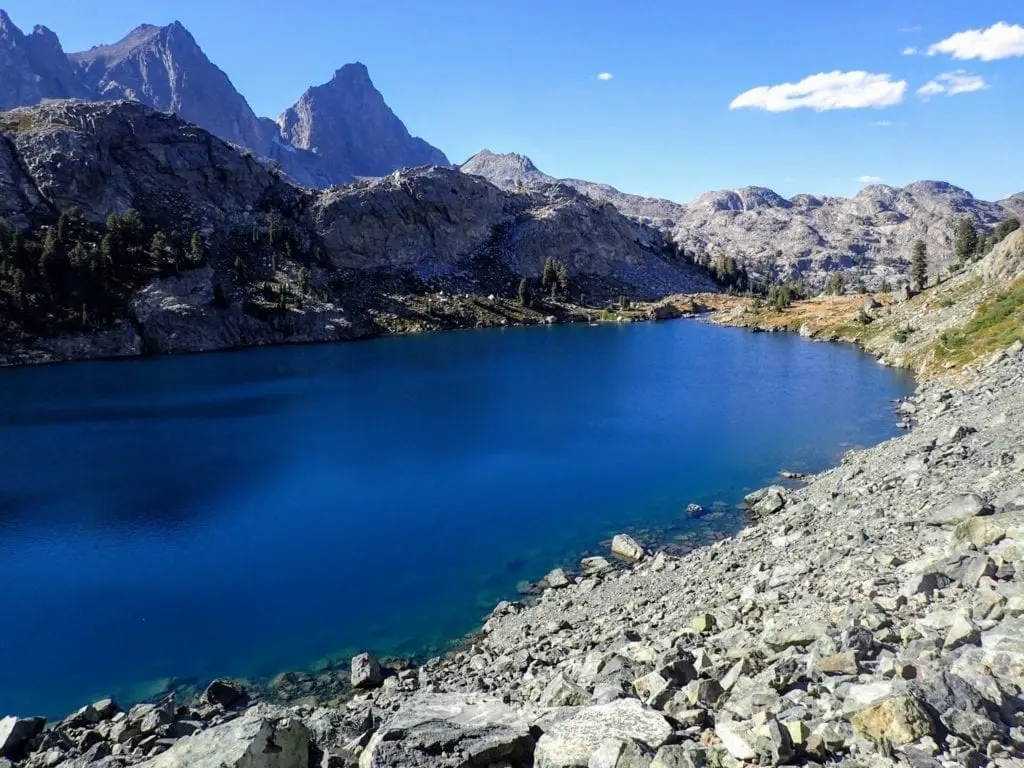
Iceberg Lake, a side trip from a remote part of the JMT where we spent a “rest day”
Difficulty
Both the JMT and CT are tough mountain trails with similar challenges: lots of climbing and descending, sections of rough rocky trail, and high elevation.
Which one is harder? In my experience the JMT is harder on a per-mile basis, but the CT’s longer mileage makes it the harder undertaking overall. Some key stats:
JMT:
- 223 feet of climb per mile on average (47,000 feet elevation gain in 211 miles)
- Highest elevation: 14,505 feet at Mt. Whitney
- Length: 211 miles
CT:
- 185 feet of climb per mile on average (89,000 feet elevation gain in 480 miles)
- Highest elevation: 13,271 feet
- Length: 480 miles
So the JMT has more elevation gain per mile; it is constantly headed up or down. The CT has a few more gradual sections to balance out all its high passes.
The JMT also has a higher max elevation, which happens to be the summit of the tallest peak in the lower 48! Topping 14,000 feet is no joke, but you’ll be well acclimated by the time you get there (heading SOBO) and altitude is a challenge on both trails.
The CT has the added difficulty of being over twice as long in mileage. Don’t underestimate the cumulative wear and tear this can cause. If all goes well and your body adjusts, you’ll be in peak shape by the end. On the other hand, more weeks on the trail means more opportunity for mental lows and nagging overuse injuries.

The JMT has a burly elevation profile with near-constant ups and downs.

The high point of the JMT is also the highest point in the lower 48 states!
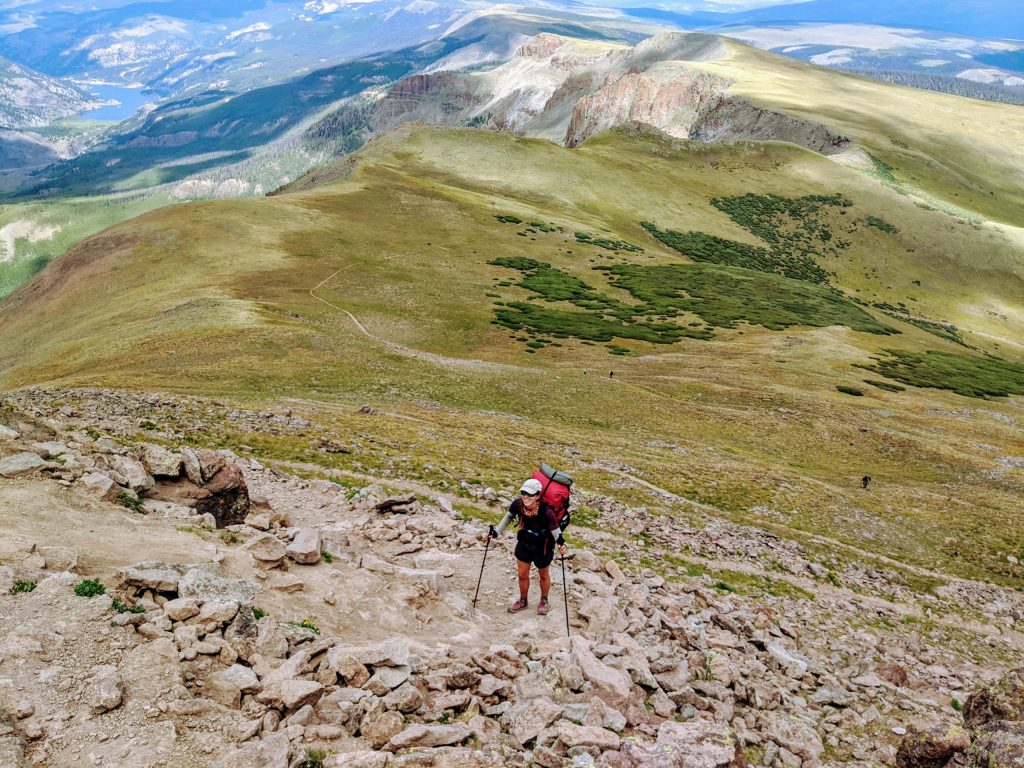
The CT has many challenging climbs and descents, but also some more gradual sections mixed in (this isn’t one of them!)
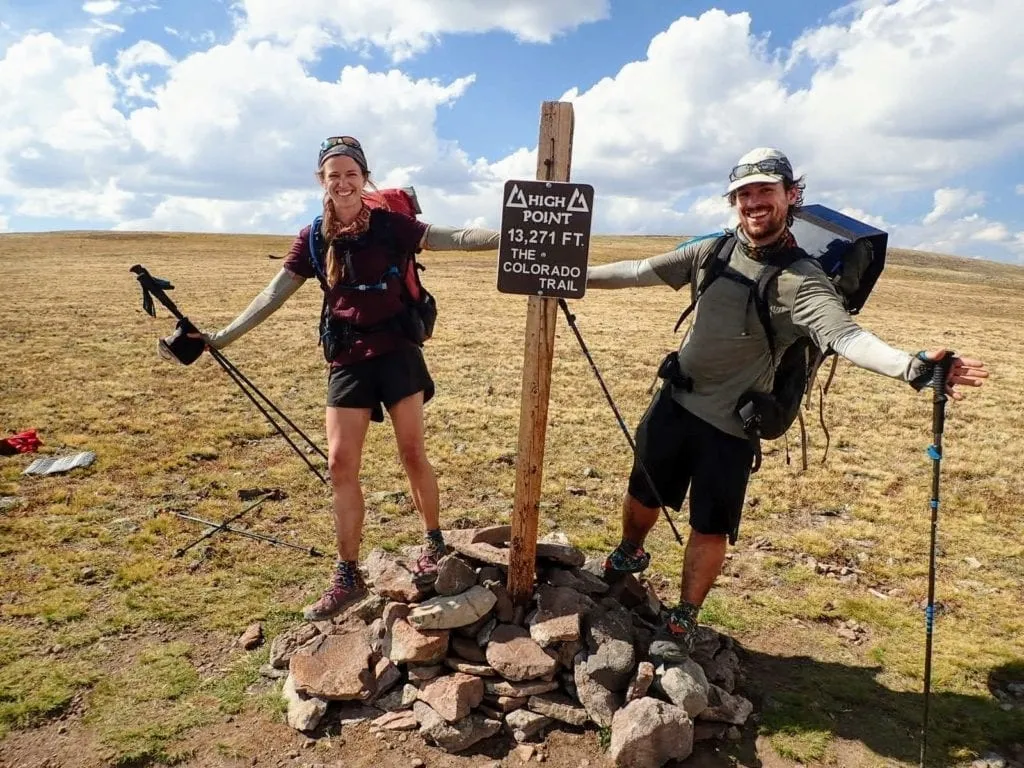
The Colorado Trail’s high point is slightly lower than the JMTs, but still formidable.
Permits
Here’s a big one: permits for the JMT are very competitive, while permits for the CT are currently not required. This makes the CT a very appealing option! You can choose your dates and even plan a very last-minute thru hike of the CT, whereas the JMT requires applying 24 weeks in advance and rolling the dice in the lottery.
Logistics and Transportation
Both the CT and JMT are point-to-point journeys, so you’ll need to think about how to get to and from each end of the trail.
The Colorado Trail runs from Denver to Durango, both populated areas, so it’s more logistically straightforward when it comes to transportation. Both endpoints have nearby airports, rental car offices, and bus stations. The only catch is the ride to/from both trailheads, which can be accomplished with help from trail angels, Uber, or hitchhiking.
The JMT runs between Yosemite National Park in the middle of nowhere and Whitney Portal in Inyo National Forest, twelve miles from the small town of Lone Pine. It is technically possible to set up your JMT hike using only public transportation, but you’ll have to patch together rides from several different small operators with limited schedules.
Car shuttlers need to know that driving between the JMT’s two endpoints takes longer than you expect. Though the JMT itself is only 211 miles, the drive is about 400 miles and takes 7 hours! It’s actually faster to drive between Denver and Durango despite the fact that the CT is over twice as long as the JMT.
When I thru hiked the JMT we set up a car shuttle among our group of four. The other two drove to Lone Pine, left a car there, and pieced together public transport to Yosemite Valley. We drove to Yosemite, left our car there, and hiked together down to Whitney Portal. We then hitchhiked to Lone Pine, drove together in their car back to Yosemite (7 hours!), then drove our own car home. Yikes, that’s a lot of transportation!
When I hiked the Colorado Trail we flew into Denver and Ubered to the start trailhead. At the end we hitchhiked from the finish trailhead into Durango and flew home from there. Much simpler than the JMT!
Resupply and Trail Towns
If you’re looking for a social trail town vibe, choose the Colorado Trail. Many of the resupply opportunities feature historic mining towns and tourist spots perfect for indulgent zero days. If your idea of a thru hike involves pizza and beer, roaming the grocery store, and an occasional lazy day in a cheap motel, the CT is your trail.
Because the Colorado Trail passes through so many towns, it’s reasonable to resupply by shopping as you go. Of course you can also mail yourself food boxes if you prefer, but it’s not mandatory. This can be nice since your tastes will surely evolve over the weeks and it’s nice to stock up on whatever appeals at the time.
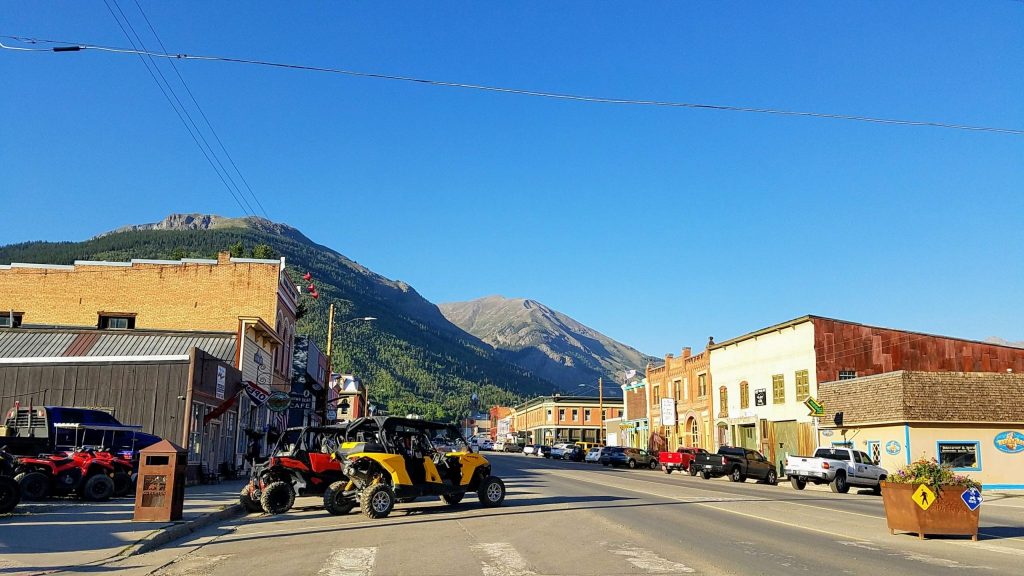
Silverton is a fun historic mining town in Colorado, and a great resupply stop.
The John Muir Trail, on the other hand, is unique among thru hikes for its lack of trail towns. All resupply stops on the JMT are fairly remote resorts where you can’t exactly grab a room, do laundry, or shop at a real grocery store. Most JMT hikers mail all their food in advance and take their zero days on the trail at an idyllic campsite, not in town.
The JMT also has an unusually long stretch between Muir Trail Ranch and Whitney Portal with no resupply (unless you hike out or hire pack mules). Most people like to linger in this gorgeous country, so it’s not uncommon to carry 8-10 days of food for this stretch. On the Colorado Trail most hikers never carry more than 7-8 days of food.
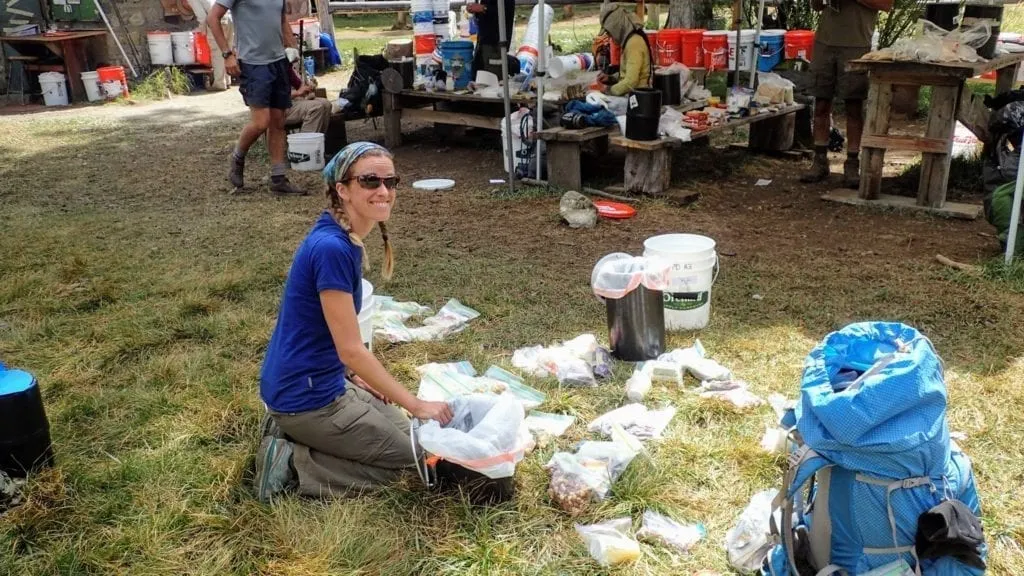
Trying to pack nine days of food into my bear canister at Muir Trail Ranch, which is not a trail town, just a place to restock and keep moving.
Scenery
Let’s be real, this is the question on every prospective thru hiker’s mind: which trail has the best scenery? We all want those jaw-dropping vistas and picture-perfect campsites.
In my opinion, the JMT has the higher density of excellent mountain scenery. Mile for mile it’s probably the most iconically beautiful longer trail in the U.S.
The Colorado Trail also has some incredibly scenic sections, particularly at high elevation. I personally found the San Juans in segment 23 to be one of the most scenic places I’ve ever experienced. But 480 miles is a lot of miles, and they can’t all be spectacular. The CT has more “junk miles” — the name I hesitate to use for stretches of less interesting forest — than the JMT does.
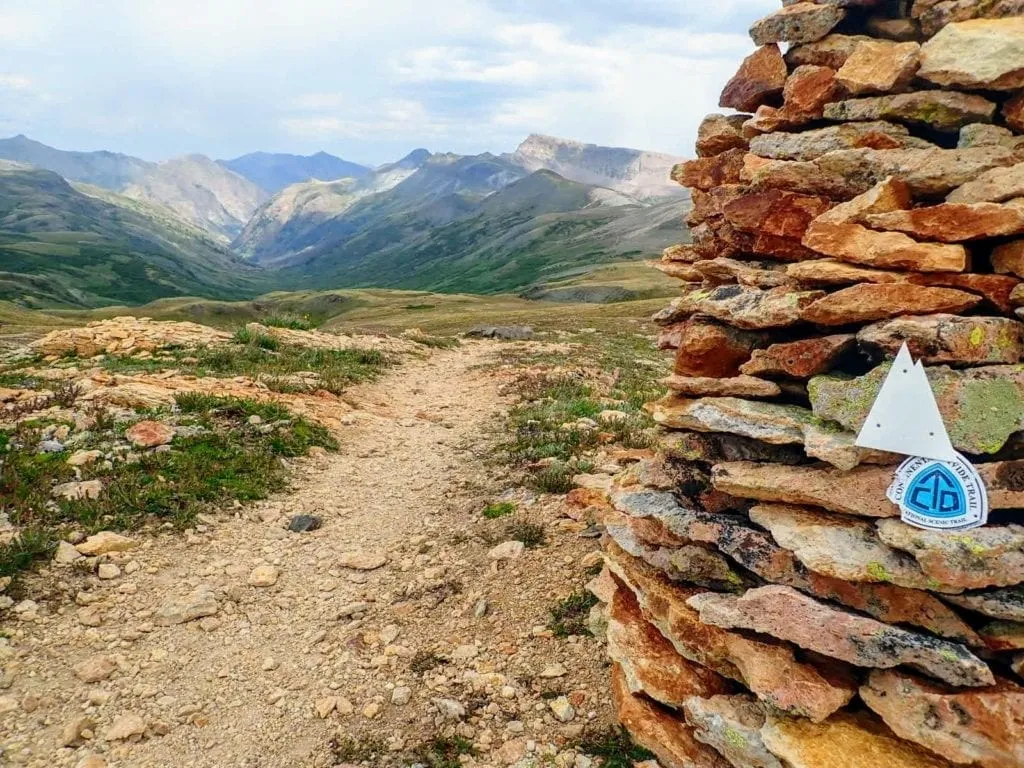
The Rockies in this part of Colorado have dramatic views, a vibrant color palate, and interesting mining history.
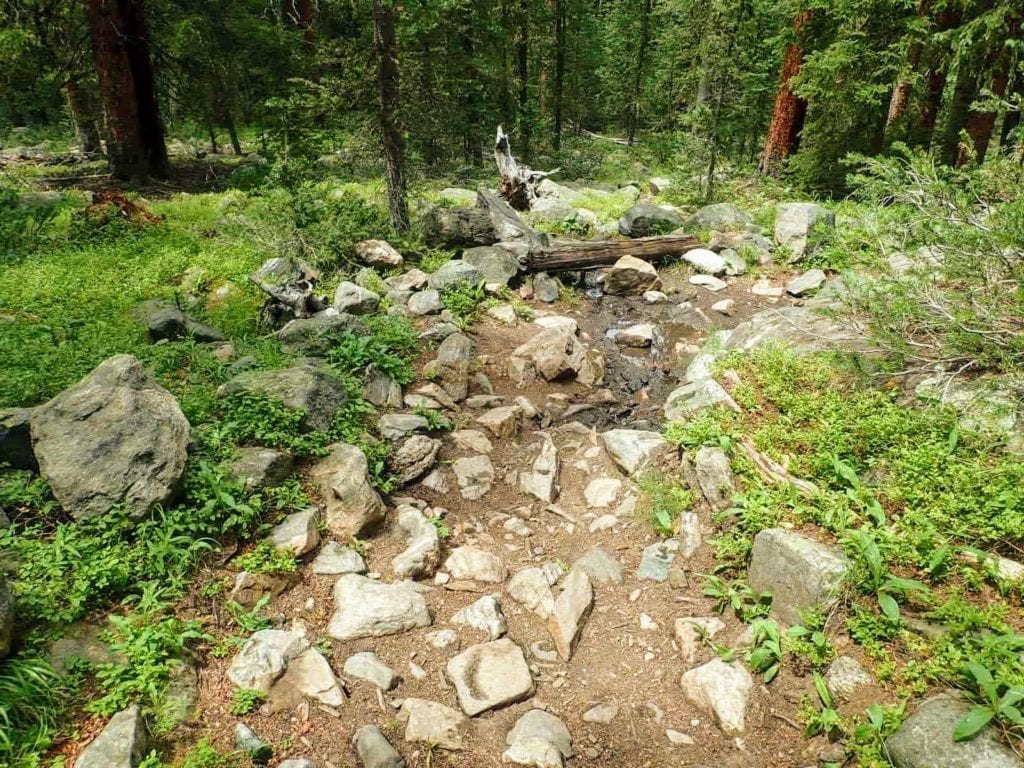
Both trails have some less appealing miles mixed in, but the Colorado Trail has more (this section is no one’s favorite!)
The Sierra Nevada and the Rockies, though both impressive mountain ranges, offer different spins on mountain scenery. The Sierra is known for granite basins, deep blue high-alpine lakes, and sharp, crumbly summits. The older Rockies in Colorado feel bigger, smoother, and more varied. I enjoyed them both, perhaps especially because they were different from each other.
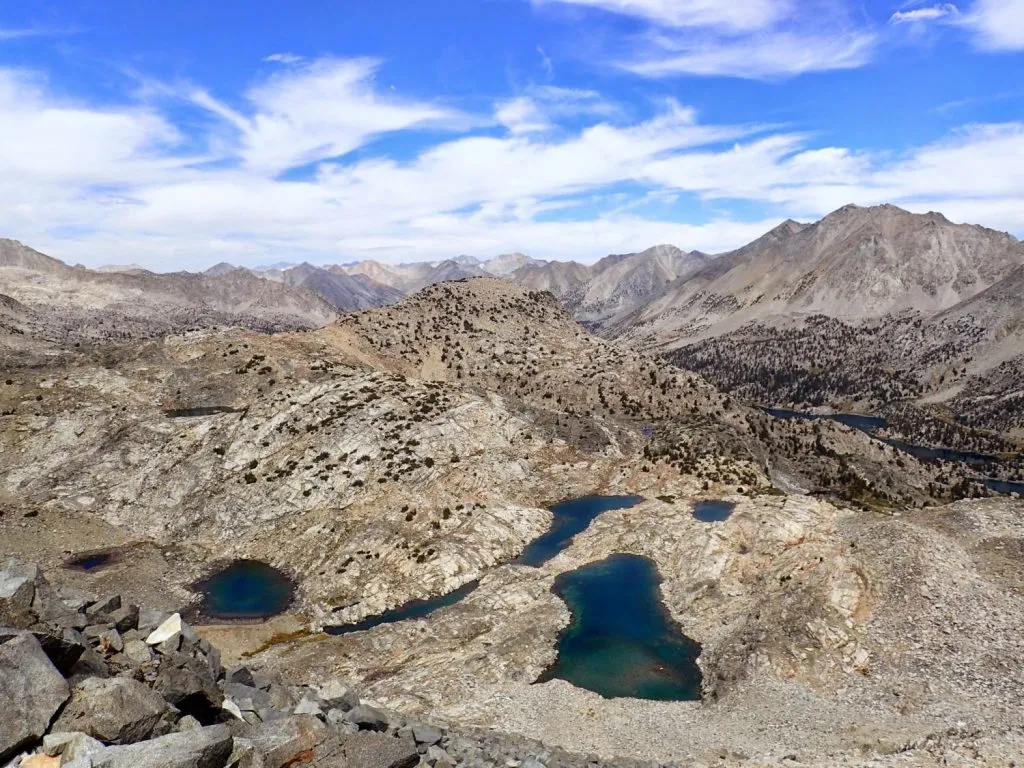
The Sierra is known for vast granite landscapes like this one
Weather
Assuming you hike within the typical summer season of July to September, rain and electrical storms are the main weather-related challenges.
Both trails are prone to afternoon thunderstorms with risk of lightning in high exposed areas, but the Colorado Trail is especially known for its monsoon-fueled electrical storms.
In July on the CT many hikers rise before the sun to get their miles in before early afternoon, making sure they’re safely over the highest passes before storm clouds build. By mid August and September the weather tends to be more stable, but it’s always smart to keep an eye on the forecast and the sky.
When I hiked the Colorado Trail from mid-July to mid-August, there were many afternoons with some rain. It rarely rained for very long, but it could dump a surprising amount in a short period of time and often brought thunder and lightening. I used my rain jacket a lot on the CT, and sometimes waited to cross passes until the weather cleared.
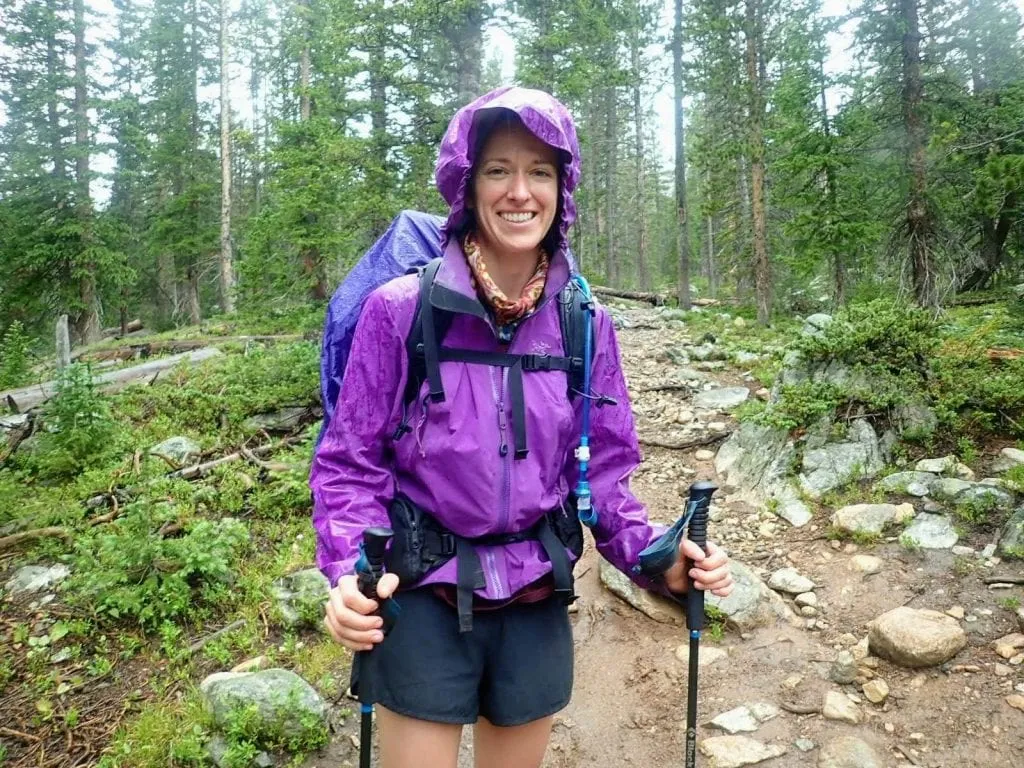
On the Colorado Trail, afternoon showers (and sometimes thunderstorms) are common.
When I hiked the John Muir Trail in early September we had just a couple days of drizzling rain and very little electrical activity, though we were always on the lookout before crossing high passes. Usually the weather was sunny and stable. Though this is in part due to the timing of my JMT hike (September versus July / Aug) the Sierra is generally known for drier summers compared to the Rockies.

The JMT tends to be a bit drier and sunnier, though storms do still happen some afternoons.
Other Trail Users
According to Wikipedia the John Muir Trail sees about 1500 thru hike attempts each year, while the Colorado Trail only sees about 500 according to the CTF. So the JMT may seem busier in that sense, but thru hikers aren’t the only folks using these trails.
The JMT is largely backpacking territory, since most day hikers can’t make it that far into the Sierra. You’ll mostly meet other JMT thru hikers, PCT thru hikers, and backpackers. Bicycles are off-limits on pretty much all of the JMT, so you won’t meet mountain bikers or bikepackers.
The Colorado Trail spends much more time in areas accessible to day hikers and mountain bikers, so it doesn’t always have that prized feeling of remoteness the JMT offers. Some segments are also popular with shorter-distance backpackers, and you’ll encounter a few CDT thru hikers in it for the long haul.
Bears, Critters, and Food Storage
Black bears and bear-hiker interactions are a problem on both trails, usually in lower elevation areas. While black bears are generally skittish and not a threat to humans, there is a risk of them becoming bolder “problem bears” if they grow accustomed to hikers and their food.
To prevent this, hard-sided bear canisters are required on almost all of the John Muir Trail. When I hiked the JMT I carried a Bearikade, the lightest bear canister available, and it was still bulky and heavy. Part of planning a JMT hike is figuring out how to fit your menu into your canister and fit your canister into your pack.
The CT does not require bear canisters, but some hikers carry them anyway for peace of mind. A good bear hang is hard to do, especially when you’re tired after a long day and night is falling. An Ursack Major bear bag can be a good compromise, and that’s what I carried on the CT, being careful to tie it securely to a tree or branch each night.
Related: Bear Bags vs. Canisters
I didn’t see any bears during my JMT thru hike, though I’ve seen them in other areas of Yosemite National park where the JMT begins. I did encounter a bear during my CT thru hike and it was rather bold, sauntering into my campsite while I ate breakfast and totally unfazed by my shouting and clanging of pots.
Critters like mice, chipmunks, and marmots are realistically the biggest threat to your food on both trails! For this reason alone it’s wise to use smart food storage and clean food prep techniques at every campsite. They’ve also been known to nibble on packs, hiking pole grips, shoes, and other yummy salty gear.

Bear canisters are required on the JMT. They’re big and heavy, but they do make nice camp stools (shown here on Bighorn Plateau).
Hiking With Dogs
If you fancy thru hiking with your furry friend, the Colorado Trail is for you. With only one short exception in segment 1, the CT is dog-friendly. Many people do hike with their dogs, though it’s important that the dog be in good shape and have foot protection from the sharp rocks if needed.
The John Muir Trail, on the other hand, spends most of its mileage in national parks (Yosemite and Sequoia / King’s Canyon) where dogs are prohibited on the trails.
Which would I hike again?
If I could only hike one of these two trails again, which would it be?
Ugh, noooo, don’t make me choose! Each is so special in its own way. The Colorado Trail was the first to make me feel like a “thru hiker,” but the JMT knocked my socks off early in my backpacking journey and led to my lasting obsession with this mode of adventuring.
Ok fine, if I had to choose only one, I’d hike the John Muir Trail again. There’s just no beating that special feeling of remoteness and ruggedness you’ll find deep in the high Sierra. But that assumes I could get a permit! 🙂 And if not, I’d happily hike the Colorado Trail again instead.
More Backpacking Resources
If you liked this post, you’ll also like these:
Or visit the backpacking section for lots more.
About the Author
Hi there, I’m Alissa, founder of Exploring Wild. I’ve had the pleasure of hiking the Arizona Trail, Colorado Trail, John Muir Trail, Tahoe Rim Trail, and countless shorter amazing trails throughout the US and abroad. I love solitude, big views, and a good lightweight gear setup. Learn more here.
Hiking resources in your inbox?
There’s more where this came from! Sign up here for occasional emails full of inspiration and information about backpacking and hiking.
Share the Adventure
If you found this article helpful, please consider sharing so more people can benefit from it:
The post John Muir Trail vs. Colorado Trail: Which is best for your next (or first) thru hike? appeared first on Exploring Wild.
https://exploringwild.com/john-muir-trail-vs-colorado-trail/?utm_source=rss&utm_medium=rss&utm_campaign=john-muir-trail-vs-colorado-trail
 CampingSurvivalistHuntingFishingExploringHikingPrivacy PolicyTerms And Conditions
CampingSurvivalistHuntingFishingExploringHikingPrivacy PolicyTerms And Conditions
